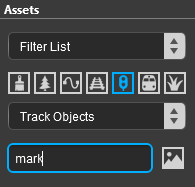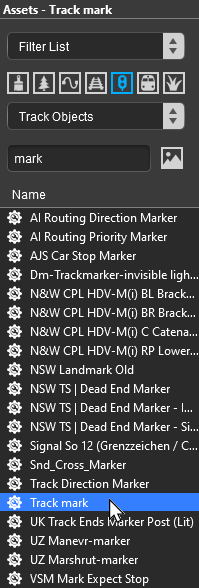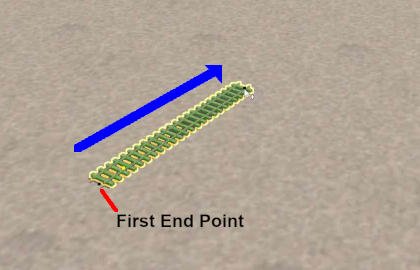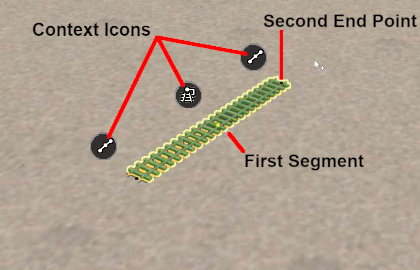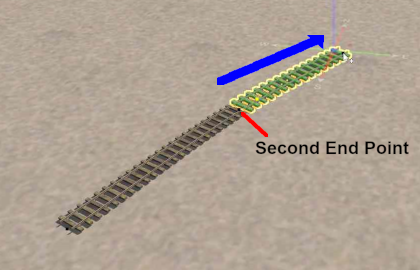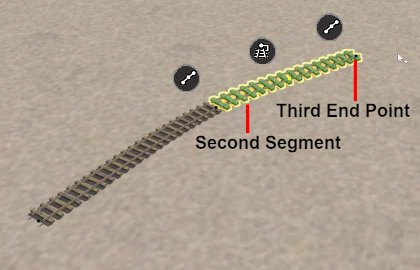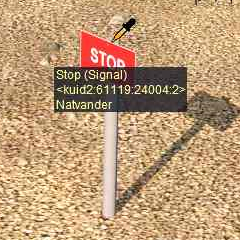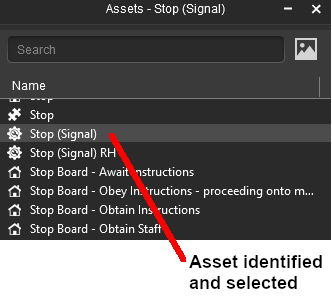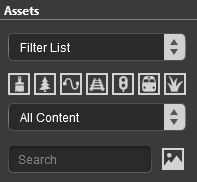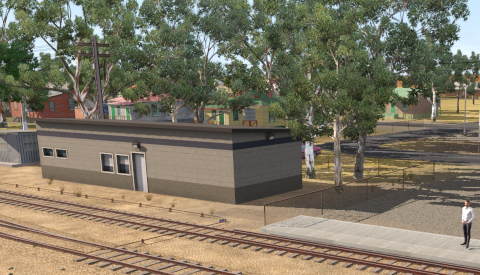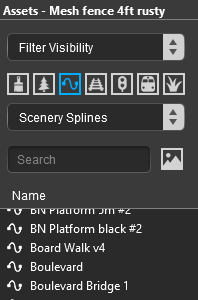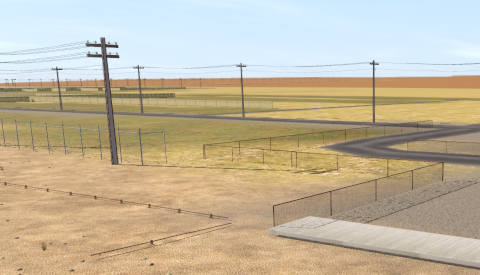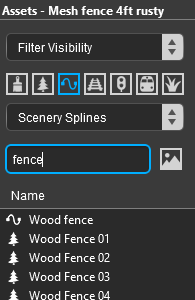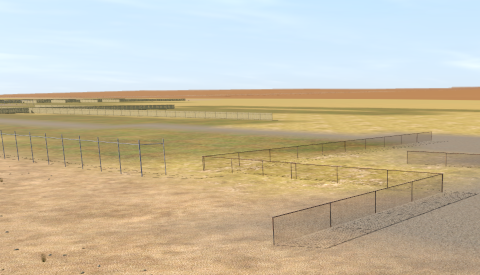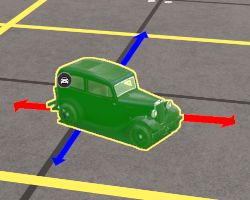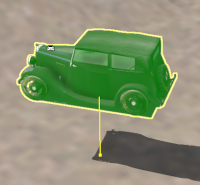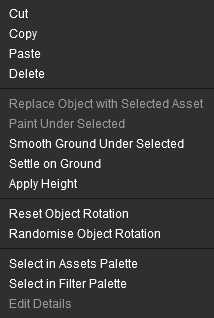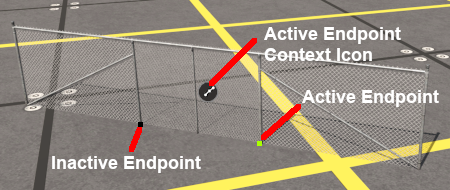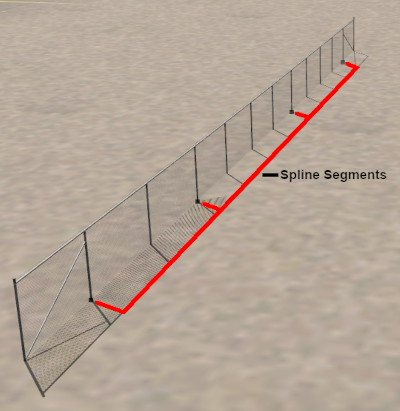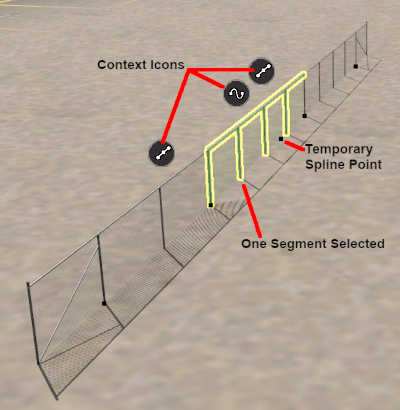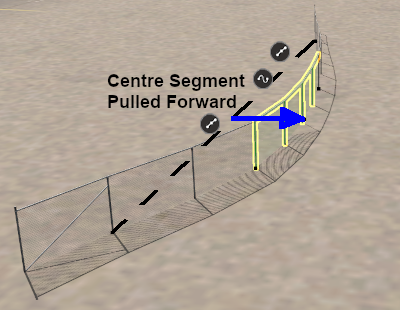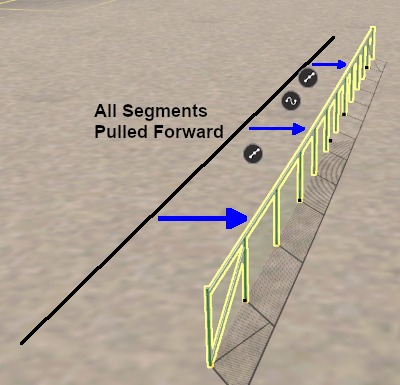How to Use S20 Tools
(→Placing a Scenery or Track Spline) |
|||
| Line 836: | Line 836: | ||
Follow the steps listed above for placing a scenery mesh object.<br> | Follow the steps listed above for placing a scenery mesh object.<br> | ||
| − | |||
| − | |||
| − | <table> | + | <table width=900> |
<tr valign="top"> | <tr valign="top"> | ||
| − | <td>[[image:PlacementTrack1_S20.png|link=]]</td> | + | <td rowspan=2 width=420>[[image:PlacementTrack1_S20.png|link=]]</td> |
<td>[[image:DotPoint1.JPG|link=]]</td> | <td>[[image:DotPoint1.JPG|link=]]</td> | ||
| + | <td>'''Click on the spot''' as shown in '''Step''' [[image:DotPoint5.JPG|link=]] above to place the start or first '''end point''' of the spline.</td> | ||
| + | </tr> | ||
| + | <tr valign="top"> | ||
| + | <td>[[image:DotPoint2.JPG|link=]]</td> | ||
<td>Move the mouse in the direction you want to lay the spline or track. The spline will follow the mouse wherever you move it.</td> | <td>Move the mouse in the direction you want to lay the spline or track. The spline will follow the mouse wherever you move it.</td> | ||
</tr> | </tr> | ||
<tr valign="top"> | <tr valign="top"> | ||
<td>[[image:PlacementTrack2_S20.png|link=]]</td> | <td>[[image:PlacementTrack2_S20.png|link=]]</td> | ||
| − | <td>[[image: | + | <td>[[image:DotPoint3.JPG|link=]]</td> |
<td>When you have the pointer in the final position for the first spline segment, '''Left''' click the mouse. This will anchor the second spline end point. The spline between the two end points is the first spline segment.<br> | <td>When you have the pointer in the final position for the first spline segment, '''Left''' click the mouse. This will anchor the second spline end point. The spline between the two end points is the first spline segment.<br> | ||
| − | + | <br> | |
The spline segment will now have three '''Context Icons''', one for each '''end point''' and one for the spline segment.</td> | The spline segment will now have three '''Context Icons''', one for each '''end point''' and one for the spline segment.</td> | ||
</tr> | </tr> | ||
<tr valign="top"> | <tr valign="top"> | ||
<td>[[image:PlacementTrack3_S20.png|link=]]</td> | <td>[[image:PlacementTrack3_S20.png|link=]]</td> | ||
| − | <td>[[image: | + | <td>[[image:DotPoint4.JPG|link=]]</td> |
| − | <td>'''Left''' click on the new end | + | <td>'''Left''' click on the new end point and move the mouse in the direction you want to continue laying the spline or track. The spline will follow the mouse wherever you move it.</td> |
</tr> | </tr> | ||
<tr valign="top"> | <tr valign="top"> | ||
| − | <td>[[image:PlacementTrack4_S20.png|link=]]</td> | + | <td rowspan=2>[[image:PlacementTrack4_S20.png|link=]]</td> |
<td>[[image:DotPoint5.JPG|link=]]</td> | <td>[[image:DotPoint5.JPG|link=]]</td> | ||
<td>When you have the pointer in the final position for the second spline segment, '''Left''' click the mouse. This will anchor the third spline end point and produce new '''Context Icons''' for the second segment.</td> | <td>When you have the pointer in the final position for the second spline segment, '''Left''' click the mouse. This will anchor the third spline end point and produce new '''Context Icons''' for the second segment.</td> | ||
| + | </tr> | ||
| + | <tr valign="top"> | ||
| + | <td>[[image:DotPoint6.JPG|link=]]</td> | ||
| + | <td>Repeat '''Steps''' [[image:DotPoint4.JPG|link=]] and [[image:DotPoint5.JPG|link=]] above to continue laying the spline.</td> | ||
</tr> | </tr> | ||
</table> | </table> | ||
| − | + | <br> | |
| − | + | ||
| − | + | ||
| − | + | ||
=='''Deleting an Asset'''== | =='''Deleting an Asset'''== | ||
Revision as of 15:50, 10 January 2023
The information in this Wiki Page applies to Surveyor 2.0 (S20) as found in Trainz Plus.
This document is under development
|
|
|||||||||
The Tools Palette
 |
|
|||||||||||||||||
The Brush Tool
The Brush Tool is used for painting the route. It can:-
When selected, the Brush Tool will show two drop down menu lists. |
 |
| The first drop down menu will set the Brush Target, the type of brush. The Targets are:- |
|||||
|
 |
|
|||
Ground Height
This brush tool uses the Tool Options Palette. If this palette is not visible on the screen then refer to Notes: Palettes at the top of this document.
| When the Ground Height Target is selected, the second drop down box will give a choice of several Ground Height tools. The choices are:- |
|
|
 |
| The available brush tool options are shown in the Tool Options Palette with a Gold coloured icon next to their names. Those options that have their icon greyed out will be ignored, but they can still be edited. | ||||||||||||||||||||||||||||||||||||
Height Up/Height Down 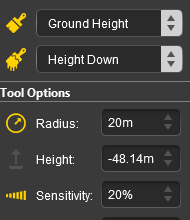 |
Set Height  |
Grade 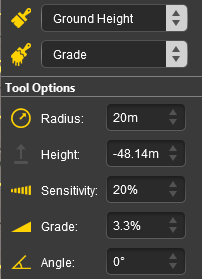 |
|
|||||||||||||||||||||||||||||||||
|
Ground Texture
This brush tool uses the Tool Options Palette. If this palette is not visible on the screen then refer to Notes: Palettes at the top of this document.
When the Ground Texture Target is selected, the second drop down box will be disabled - there are no brush texture tool choices.
The available brush tool options are shown in the Tool Options Palette with a Gold coloured icon next to their names. Those options that have their icon greyed out will be ignored, but they can still be edited.
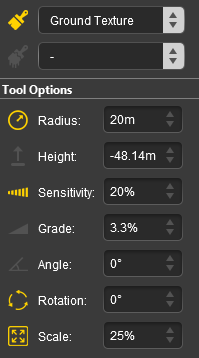 |
|
||||||||||||||||||||||||||||
|
Scrapbook Data
This brush tool uses both the Tool Options Palette and the Scrapbook Palette. If these palettes are not visible on the screen then refer to Notes: Palettes at the top of this document.
|
| The Scrapbook Brush When the Scrapbook Data Target is selected, the second drop down box will give a choice of two Scrapbook Data tools. |
|
|
|
|
| The available brush tool options are shown in the Tool Options Palette with a Gold coloured icon next to their names. Those options that have their icon greyed out will be ignored, but they can still be edited. | |||||||||||||||||||||||||||||||||||
Scrapbook Brush 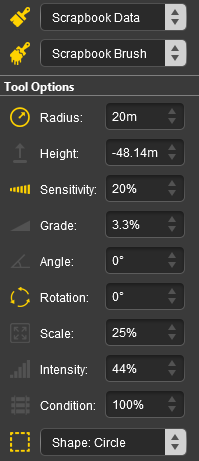 |
Scrapbook Clone  |
|
|||||||||||||||||||||||||||||||||
|
The Scrapbook Palette  |
|
|||||||||||||||||||||||||||||||||||||||||||
Edit Effect Layers...
When this Target is selected, the Edit Effect Layers options will appear. This is the same as selecting Edit Effect Layers ... from the Trainz Edit Menu.
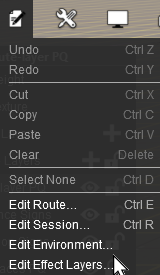 |
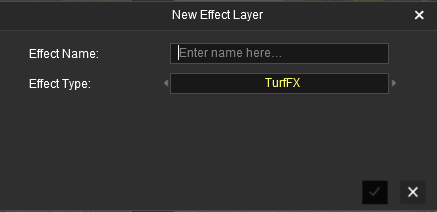 |
 |
 |
More information on creating and editing Effect Layers can be found on the Trainz Wiki at:- |
The Placement Tool
The Placement Tool is used to add objects to the route. This tool uses the Assets Palette. If this palette is not visible on the screen then refer to The first step is to identify and select the particular object that you want to add to the route. Placing a Scenery Mesh ObjectIndividual "non-spline" scenery objects that are not attached to track are often referred to in Trainz terminology as Scenery Mesh Objects.
Placing a Scenery or Track SplineFollow the steps listed above for placing a scenery mesh object.
Deleting an Asset
Adding Spline ObjectsScenery splines and track splines are defined by their end points. Splines are usually added to a route as a series of joined segments linked at the end points. Adding scenery and track splines to a routs is simply a matter of adding new end points.
The Eyedropper Tool
|
|||||||||||||||||||||||||||||||||||||||||||||||||||||||||||||||||||||||||||||||||||||||||||||||||||||||||||||||||||||||||||||||||||||||||||||||||||||||||||||||||||||||||||||||||||||||||||||||||




